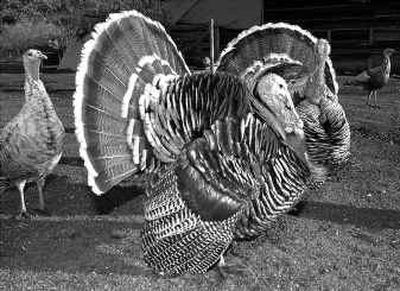Gourmet gobblers

LOS ANGELES — It’s a turkey with a proud heritage, so much so that gourmet cooks seem to be flocking to poultry farms this Thanksgiving season to buy one.
Mary and Rick Pitman say the phone at their Fresno, Calif.-area farm has hardly stopped ringing since summer. The question is always the same: Is there still time to reserve a heritage turkey for today’s feast?
“There’s such a huge demand for these turkeys, I’ve never seen anything like it,” said Mary Pitman. Even a heritage bird’s price of $3 to $7 a pound — a factory farm-raised turkey costs $1.40 a pound — doesn’t faze the callers.
Consumers with discerning palates say it’s a small price to pay for a bird they find tastier and more flavorful than the modern, mass-produced turkeys found in supermarkets. People from as far away as Florida have been calling Sylvia Mavalwalla’s farm in Petaluma to order one, and those who live nearby insist on driving straight to her ranch to pick up a fresh bird.
With word about heritages spreading, the Pitmans say they expect to sell 6,000 birds this year, 5,000 more than last year when they first started raising them. Mavalwalla said she will sell 110, up from 45 last year.
About 274 million turkeys were raised in the United States in 2003, according to the U.S. Department of Agriculture, and most of them were mass-produced Broadbreasted White turkeys.
A census conducted in 1997 by the American Livestock Breeds Conservancy found only 1,335 heritage turkeys in the country. This year, about 20,000 were raised, according to Slow Food USA, which launched a campaign in 2001 to reacquaint Americans with the birds.
Preservationists believe revived interest in eight varieties of turkeys such as the American Bronze, Bourbon Red and Narragansett will help keep the food supply diverse and save the breeds from extinction.
“When talking about certain animals being raised for food, if no one eats them then they become endangered,” said Erika Lesser, executive director of Slow Food USA. “You ensure their survival by consuming and ensuring demands for them.”
People who want to try a heritage bird may have missed out this year, but Lesser says they can reserve early for next year. That way farmers can plan the year’s stock.
Heritage turkeys take eight months to fully develop, while a commercial turkey has about a 3-month life span. The Broadbreasted White turkeys were developed in the 1950s to come to market faster and fatter, and they’ve lost the ability to run, fly and breed naturally.
The Pitmans say their turkeys are fed a high-protein grain diet and are given four times as much roaming space as factory-raised turkeys. As a result, their live weights range from 7 to 20 pounds, compared with 27 pounds for an average Broadbreasted White.
Heritage turkeys are also more “animated and social” than Broadbreasted Whites, says Mary Pitman, who raises both.
“When you go out there, they follow you whereas other birds would run away from you,” she said. “When you get excited, they get excited. And they’re beautiful, they have intense bronze, purple feathers.”
Farmers say it is worth the added time and money it takes to raise them.
“I wouldn’t do it if I wasn’t making a profit,” Mavalwalla said.
For Pitman, raising the birds is also part of a personal crusade. She switched to eating pure foods two decades ago after she began developing allergies and her body couldn’t digest processed food.
“I feel strongly about the way my turkeys are raised because of my own health,” she said.